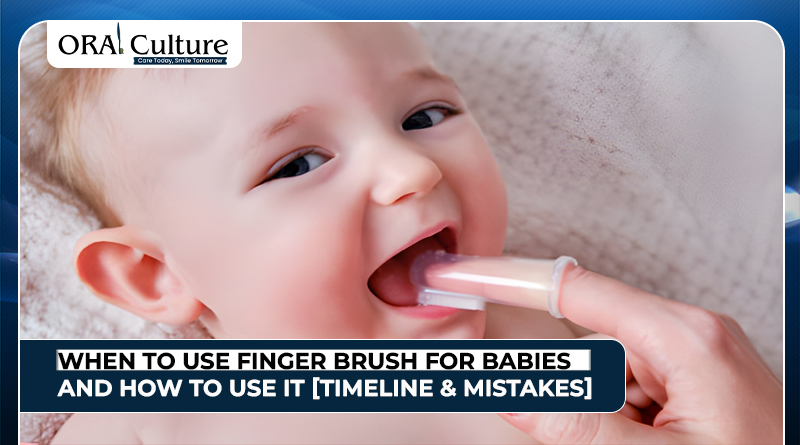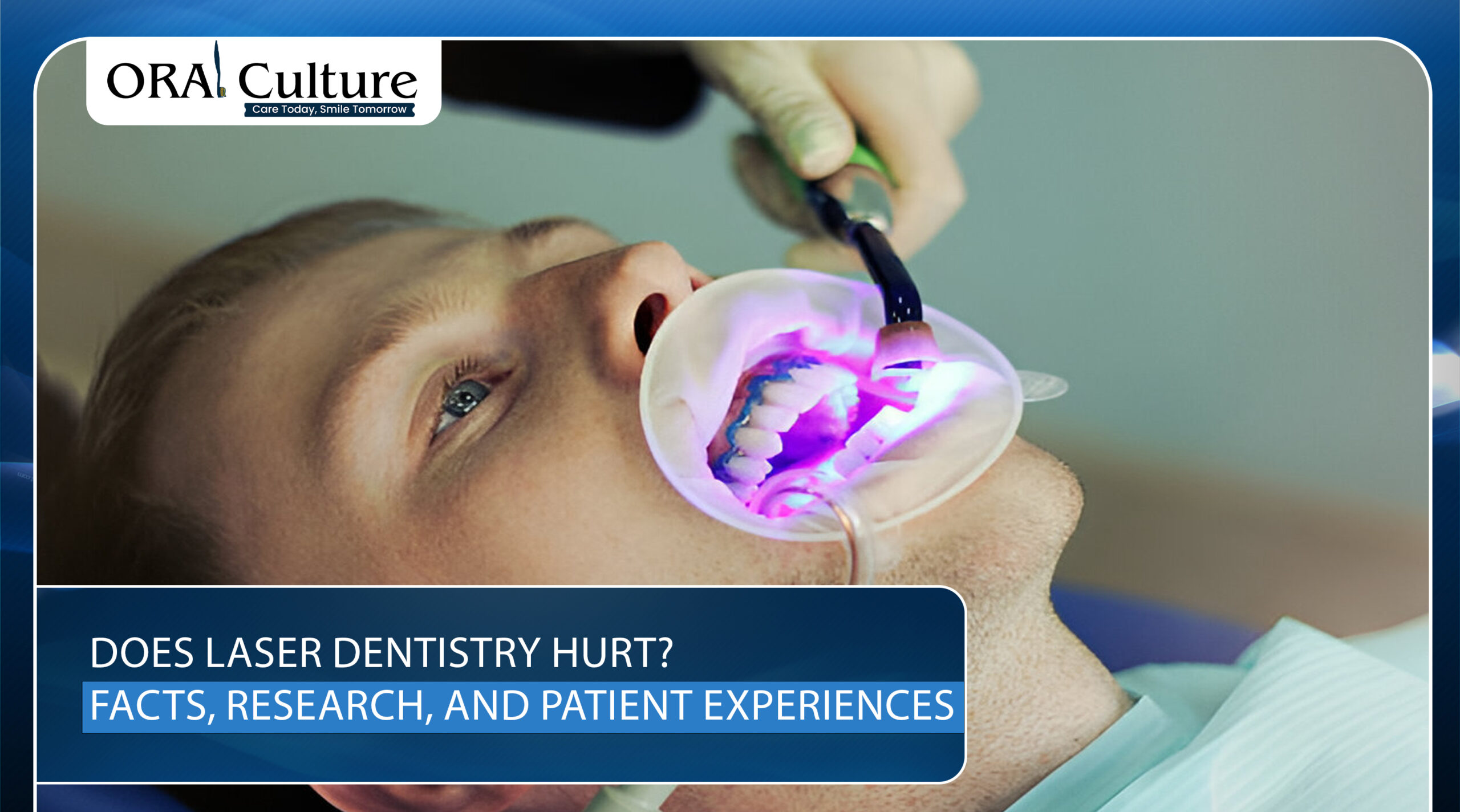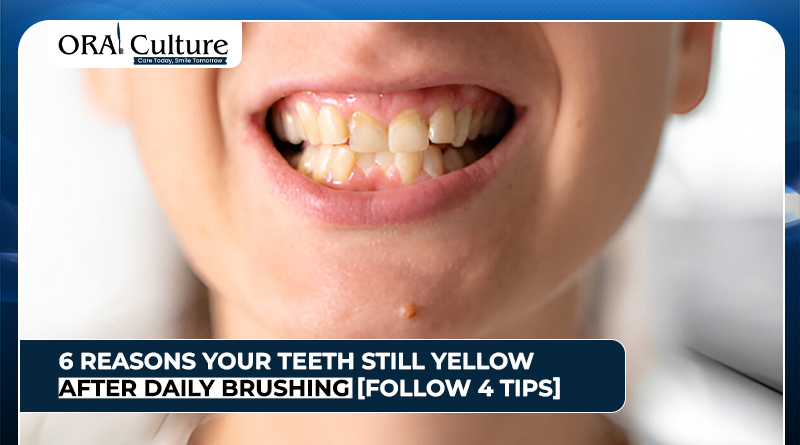Your teeth can still look yellow even after daily brushing due to factors like enamel thinning, diet, and habits like smoking or excessive coffee.
The truth is, brushing alone doesn’t always tackle all the causes of tooth discoloration. Let’s break down common reasons and share tips to help you brighten that smile.
6 Reasons Your Teeth are Still Yellow after Brushing
Are you brushing daily but still seeing yellow teeth? It’s not just about hygiene; several other factors could be dulling your smile.
1. Enamel Erosion: The Top Culprit
Enamel erosion is one of the most frequent causes of yellow teeth. The outermost covering of your teeth is called naturally white tooth enamel. However, several conditions might cause enamel to erode over time. Your teeth will appear yellow as the enamel thins and the yellowish dentin layer beneath it shows through.
How Does This Happen?
- Acidic Foods and Drinks: Beverages like coffee, soda, and citrus fruits can gradually erode enamel.
- Aggressive Brushing: Too much force or using a hard-bristled toothbrush can potentially erode enamel.
Once enamel is worn down, brushing alone won’t be enough to restore the white appearance of your teeth.
2. Diet and Staining Foods
Certain foods and drinks can stain teeth even with regular brushing. Pigments found in coffee, tea, red wine, and dark berries can adhere to enamel and cause discoloration. Though brushing can remove surface stains, some substances penetrate the enamel and cause deeper, more stubborn discoloration.
For example, if you frequently consume coffee or tea, these beverages can leave behind yellowish stains on your teeth. The tannins in these drinks stick to your enamel and contribute to yellowing, even if you brush afterward.
3. Smoking and Tobacco Use
Smoking or using tobacco products is another major cause of yellow teeth. Your teeth can become severely stained by the nicotine and tar found in cigarettes and chewing tobacco. Because tobacco products can leave residues that adhere to the surface of your teeth, these stains are frequently difficult to get rid of with routine brushing.
Over time, smoking can cause not only yellow teeth but also more severe discoloration, leading to brownish or even black stains. If smoking is the main reason behind your yellow teeth, quitting will prevent further staining.
4. Genetics: Natural Tooth Color
Some individuals just have thinner or more yellowish enamel from birth. If your family members have yellowish teeth, you may be genetically predisposed to the same tooth color.
Even with proper oral hygiene, brushing alone may not be enough to achieve a perfectly white smile if your enamel is naturally thinner or more yellow.
5. Aging and Natural Wear
Your enamel naturally wears down as you age, and the underlying dentin becomes more visible. Even if you take great care of your teeth by brushing regularly, aging can still cause your teeth to become more yellow as enamel becomes thinner.
Older adults often notice more pronounced yellowing, as their enamel has been exposed to years of wear and tear.
6. Medications & Medical Conditions
Some antibiotics, like tetracycline, when taken during childhood, can lead to permanent discoloration.
In addition to medications, medical conditions such as dry mouth or certain autoimmune diseases can also affect oral health, leading to tooth yellowing.
How to Address Yellow Teeth Despite Brushing?
There are a few things you can do if you brush your teeth every day but they still appear yellow:
1. Switch to a Whitening Toothpaste (But Manage Expectations)
Not all toothpastes are created equal. Whitening toothpaste is designed to fight surface stains using mild abrasives or gentle chemical agents like hydrogen peroxide. It’s a great first step for tackling day-to-day discoloration caused by coffee or red wine.
2. Consider Professional Whitening Treatments
If over-the-counter solutions aren’t cutting it, your best bet might be visiting the dentist. Professional whitening treatments can lift even the most stubborn stains, often in just one or two sessions.
These treatments use stronger bleaching agents that go beyond the surface, giving visible results quickly and safely.
3. Be Mindful of What You Eat and Drink
Did you know your daily cup of coffee might be the culprit behind your yellow teeth? Strongly pigmented foods and beverages, such as red wine, tea, coffee, soy sauce, and berries, can cause your enamel to discolor over time.
Instead of completely eliminating them, try this: rinse your mouth with water after consuming dark liquids and use a straw. Wait around half an hour before picking up your toothbrush because brushing soon after eating acidic foods can cause more harm than good.
4. Cut the Habit: Quit Smoking or Vaping
Whether it’s cigarettes or even vaping, the nicotine and tar cling to your enamel and cause deep, stubborn stains that are hard to remove with brushing alone.
Quitting tobacco products isn’t just good for your teeth, it benefits your gums, breath, overall health, and even your confidence. If quitting feels hard, look into support programs or nicotine alternatives to help you transition smoothly.
Conclusion
Even when you clean your teeth frequently, having yellow teeth can be a frustrating problem. However, knowing the causes will help you take the proper actions to improve your smile. Addressing the underlying reason is essential to stopping more discoloration, whether it be heredity, smoking, nutrition, or enamel degradation.
If you want more tips on oral health and keeping your smile bright, visit Oral Culture, your source for expert advice on dental care.
People Also Ask
Can brushing alone whiten my teeth?
Brushing alone helps maintain oral hygiene and can remove surface stains, but it’s not always enough to whiten yellow teeth, especially if the discoloration is deep or caused by enamel erosion.
How can I prevent yellow teeth in the future?
To prevent yellow teeth, avoid acidic foods and beverages, quit smoking, brush twice a day with fluoride toothpaste, and schedule routine dental cleanings.
How long does it take to use toothpaste to whiten teeth?
For surface stains, it may take a few weeks of regular use of whitening toothpaste before any discernible effects are seen. Professional treatments might be required for deeper stains.






